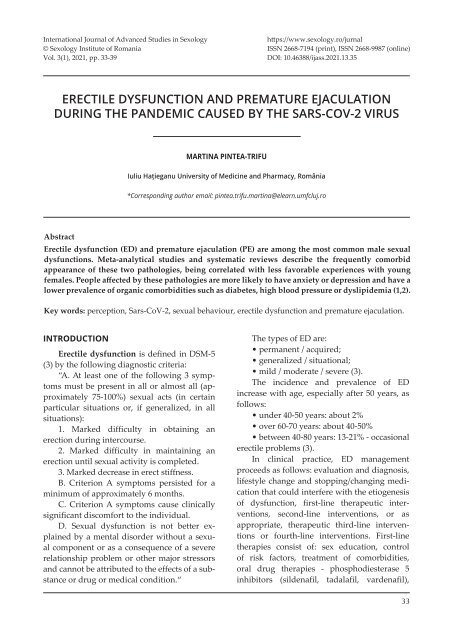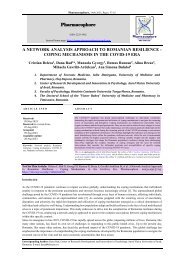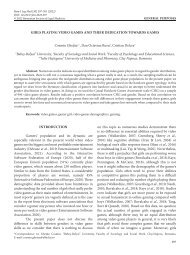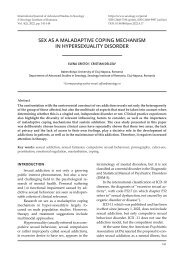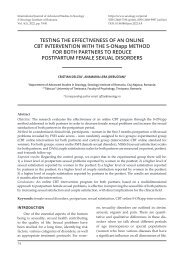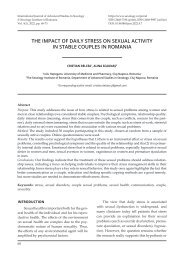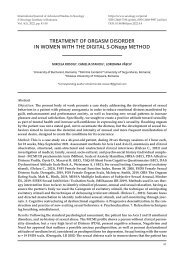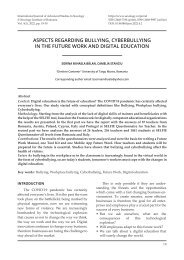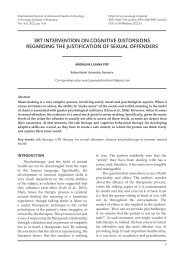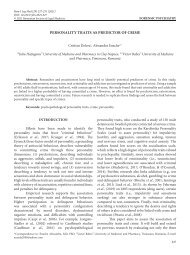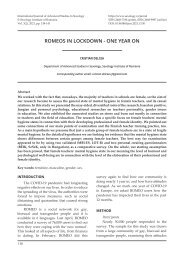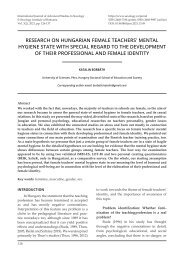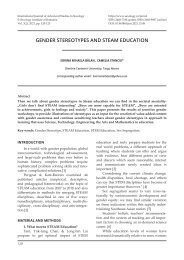33-39 Martina Pintea-Trifu - Erectile dysfunction and premature ejaculation
Create successful ePaper yourself
Turn your PDF publications into a flip-book with our unique Google optimized e-Paper software.
International Journal of Advanced Studies in Sexology<br />
© Sexology Institute of Romania<br />
Vol. 3(1), 2021, pp. <strong>33</strong>-<strong>39</strong><br />
https://www.sexology.ro/jurnal<br />
ISSN 2668-7194 (print), ISSN 2668-9987 (online)<br />
DOI: 10.46388/ijass.2021.13.35<br />
ERECTILE DYSFUNCTION AND PREMATURE EJACULATION<br />
DURING THE PANDEMIC CAUSED BY THE SARS-COV-2 VIRUS<br />
MARTINA PINTEA-TRIFU<br />
Iuliu Hațieganu University of Medicine <strong>and</strong> Pharmacy, România<br />
*Corresponding author email: pintea.trifu.martina@elearn.umfcluj.ro<br />
Abstract<br />
<strong>Erectile</strong> <strong>dysfunction</strong> (ED) <strong>and</strong> <strong>premature</strong> <strong>ejaculation</strong> (PE) are among the most common male sexual<br />
<strong>dysfunction</strong>s. Meta-analytical studies <strong>and</strong> systematic reviews describe the frequently comorbid<br />
appearance of these two pathologies, being correlated with less favorable experiences with young<br />
females. People affected by these pathologies are more likely to have anxiety or depression <strong>and</strong> have a<br />
lower prevalence of organic comorbidities such as diabetes, high blood pressure or dyslipidemia (1,2).<br />
Key words: perception, Sars-CoV-2, sexual behaviour, erectile <strong>dysfunction</strong> <strong>and</strong> <strong>premature</strong> <strong>ejaculation</strong>.<br />
INTRODUCTION<br />
<strong>Erectile</strong> <strong>dysfunction</strong> is defined in DSM-5<br />
(3) by the following diagnostic criteria:<br />
“A. At least one of the following 3 symptoms<br />
must be present in all or almost all (approximately<br />
75-100%) sexual acts (in certain<br />
particular situations or, if generalized, in all<br />
situations):<br />
1. Marked difficulty in obtaining an<br />
erection during intercourse.<br />
2. Marked difficulty in maintaining an<br />
erection until sexual activity is completed.<br />
3. Marked decrease in erect stiffness.<br />
B. Criterion A symptoms persisted for a<br />
minimum of approximately 6 months.<br />
C. Criterion A symptoms cause clinically<br />
significant discomfort to the individual.<br />
D. Sexual <strong>dysfunction</strong> is not better explained<br />
by a mental disorder without a sexual<br />
component or as a consequence of a severe<br />
relationship problem or other major stressors<br />
<strong>and</strong> cannot be attributed to the effects of a substance<br />
or drug or medical condition.“<br />
The types of ED are:<br />
• permanent / acquired;<br />
• generalized / situational;<br />
• mild / moderate / severe (3).<br />
The incidence <strong>and</strong> prevalence of ED<br />
increase with age, especially after 50 years, as<br />
follows:<br />
• under 40-50 years: about 2%<br />
• over 60-70 years: about 40-50%<br />
• between 40-80 years: 13-21% - occasional<br />
erectile problems (3).<br />
In clinical practice, ED management<br />
proceeds as follows: evaluation <strong>and</strong> diagnosis,<br />
lifestyle change <strong>and</strong> stopping/changing medication<br />
that could interfere with the etiogenesis<br />
of <strong>dysfunction</strong>, first-line therapeutic interven<br />
tions, second-line interventions, or as<br />
appropriate, therapeutic third-line interventions<br />
or fourth-line interventions. First-line<br />
therapies consist of: sex education, control<br />
of risk factors, treatment of comorbidities,<br />
oral drug therapies - phosphodiesterase 5<br />
inhibitors (sildenafil, tadalafil, vardenafil),<br />
<strong>33</strong>
MARTINA PINTEA-TRIFU<br />
phytotherapy, sex therapy <strong>and</strong> couple therapy<br />
with a psychotherapist accredited in the field.<br />
Second-line therapies are: vacuum devices,<br />
intra cavernous injections (alprostadil-PGE1),<br />
intraurethral applications of alprostadil.<br />
Third-line therapy considers: intracavernous<br />
injections with substances with an increased<br />
risk of side effects such as priapism (papaverine,<br />
phentolamine, eg Trimix, Bimix). Fourthline<br />
therapy uses surgical penile implants<br />
(malleable or inflatable penile prostheses),<br />
implantable reservoirs, or reconstructive<br />
vascular surgery (4,5).<br />
Premature <strong>ejaculation</strong> has the following<br />
diagnostic criteria in DSM-5 (3):<br />
“A. A persistent or recurrent pattern<br />
of <strong>ejaculation</strong> that occurs during sexual<br />
intercourse with a partner approximately 1<br />
minute after vaginal penetration <strong>and</strong> before<br />
the individual so desires.<br />
B. The symptom of Criterion A must be<br />
present for at least 6 months <strong>and</strong> must be<br />
present in all or almost all (approximately 75-<br />
100%) sexual acts (in certain known situations,<br />
or if generalized, in all situations).<br />
C. The symptom of criterion A causes clinically<br />
significant discomfort to the individual.<br />
D. Sexual <strong>dysfunction</strong> cannot be better explained<br />
by a mental disorder without a sexual<br />
component or as a consequence of a serious<br />
problem in the couple’s relationship or other<br />
major stressors <strong>and</strong> cannot be attributed to<br />
the effects of a substance / drug or condition.<br />
medical.“<br />
The types of EP are:<br />
• permanent / acquired<br />
• generalized / situational<br />
• mild / moderate / severe.<br />
The prevalence of <strong>premature</strong> <strong>ejaculation</strong><br />
can be summarized as follows:<br />
• over 20-30% of men between the ages of<br />
18-70 describe that they are concerned about<br />
the short interval after which they ejaculate;<br />
• 1-3% of men meet the above criteria (3).<br />
The treatment of <strong>premature</strong> <strong>ejaculation</strong><br />
takes into account its type / cause. It is intended<br />
to increase self-esteem <strong>and</strong> positive body image,<br />
comfort in the couple, individual relaxation,<br />
control of the pelvic muscles, formation of a<br />
hierarchy of sexual stimuli, sexual relaxation in<br />
the couple, sensory exercises-focus, stop-start<br />
technique, sexual contact with relaxed pelvic<br />
muscles. Sex therapy can be supplemented<br />
with antidepressant medication (eg serotonin<br />
reuptake inhibitors, dual antidepressants),<br />
anxiolytics (benzodiazepines-alprazolam,<br />
lorazepam), creams with local anesthetic,<br />
various devices (rubber penial ring),<br />
electrostimulation, biofeedback, the treatment<br />
of associated pathologies (6).<br />
MATERIAL AND METHOD<br />
The purpose of the research is to study<br />
whether the p<strong>and</strong>emic period caused by the<br />
SARS-CoV-2 virus had any influence on two of<br />
the most common male sexual <strong>dysfunction</strong>s -<br />
erectile <strong>dysfunction</strong> <strong>and</strong> <strong>premature</strong> <strong>ejaculation</strong>.<br />
The design of the study is analytical<br />
(research of risk factors), observational,<br />
longitudinal, retrospective.<br />
The subjects of the study are the<br />
respondents of an anonymous Google Forms<br />
questionnaire, which assesses the presence <strong>and</strong><br />
specifiers of erectile <strong>dysfunction</strong> <strong>and</strong> <strong>premature</strong><br />
<strong>ejaculation</strong>, in the p<strong>and</strong>emic context caused by<br />
COVID-19. The invitation to participate in the<br />
study was made by email <strong>and</strong> by distributing<br />
the questionnaire online (on the social network<br />
Facebook or WhatsApp), so as to reach<br />
respondents men, adults, of all ages, from<br />
different backgrounds, from the Romanian<br />
cultural space, which were <strong>and</strong> have not been<br />
confirmed with SARS-CoV-2 virus infection.<br />
The criteria for including study participants<br />
are:<br />
• informed consent to participate in the<br />
study;<br />
• male sex;<br />
• age over 18 years;<br />
The exclusion criteria are:<br />
• lack of informed consent to participate in<br />
the study;<br />
• female gender;<br />
• age under 18 years.<br />
The data collected from Google Forms<br />
were sorted <strong>and</strong> processed using the Numbers<br />
program, <strong>and</strong> the statistical significance was<br />
34
<strong>Erectile</strong> <strong>dysfunction</strong> <strong>and</strong> <strong>premature</strong> <strong>ejaculation</strong> during the p<strong>and</strong>emic caused by the SARS-CoV-2 virus<br />
calculated using MedCalc. The established<br />
statistical significance threshold was p
MARTINA PINTEA-TRIFU<br />
Figure 5. The moment of appearance of the ED<br />
Figure 7. The moment of appearance of the PE<br />
Figure 8. The presence of PE symptoms<br />
Figure 6. The presence of ED symptoms<br />
Premature <strong>ejaculation</strong><br />
EP, meeting the diagnostic criteria, was<br />
found in 2.96% of cases. 1.48% of patients developed<br />
it during the p<strong>and</strong>emic <strong>and</strong> 1.48% had<br />
<strong>dysfunction</strong> before the p<strong>and</strong>emic (Figure 7).<br />
20 study participants say they ejaculate<br />
before they want to, about 1 minute after<br />
vaginal penetration (Figure 8). In 8.1% of<br />
subjects the symptom persisted for more than<br />
6 months, in all or almost all (approximately<br />
75-100%) sexual acts. In a proportion of 8.1%,<br />
the <strong>dysfunction</strong> causes clinically significant<br />
discomfort. 12.6% went through a major stress<br />
during the p<strong>and</strong>emic that could have caused<br />
them the problem. For 9.6% of the studied<br />
group, sexual disorder is generalized, for 11.1%<br />
it is situational, for 10.4% it is mild <strong>and</strong> for 2.2%<br />
it is severe (Figure 9).<br />
The rate of chances, regarding the<br />
correlation between the occurrence of<br />
<strong>premature</strong> <strong>ejaculation</strong> depending on COVID<br />
Figure 9. The severity of PE<br />
19 infection, is OR = 1.97 (95% CI 0.2694 to<br />
14.5120), p = 0.502. The rate of chances for the<br />
correlation in EP <strong>and</strong> self-isolation / quarantine<br />
is OR = 0.576 (95% CI 0.0583 to 5.6972), p = 0.637.<br />
In the studied group, no patients with both<br />
diagnoses, ED <strong>and</strong> PE, were identified.<br />
Most respondents believe that the p<strong>and</strong>emic<br />
did not affect their sexual performance, while<br />
some respondents were positively or negatively<br />
affected, according to Table 1.<br />
36
<strong>Erectile</strong> <strong>dysfunction</strong> <strong>and</strong> <strong>premature</strong> <strong>ejaculation</strong> during the p<strong>and</strong>emic caused by the SARS-CoV-2 virus<br />
In a positive way<br />
It didn’t affect me, on the contrary<br />
In a good way....<br />
It was better. I traveled with a delegation, I made love in<br />
several cities flying freely by car. I made love in the car during<br />
the p<strong>and</strong>emic several times. In a p<strong>and</strong>emic you can make love:<br />
in the parking lot of Therme, because it is deserted, on the<br />
country roads, in hotels in the country because we were the<br />
only customers. The only impediment was that I had to make<br />
my written statement to make love. And it was exciting in the<br />
p<strong>and</strong>emic that “I penetrated the system” <strong>and</strong> the nonsense<br />
of rules, emergencies or alerts. The p<strong>and</strong>emic ghost: “If it<br />
becomes completely isolated <strong>and</strong> it will be deserted on the<br />
street, I would like to make love with my girlfriend on the roof<br />
of Cotroceni while the president is skiing.”<br />
Yes, I noticed an improvement in performance<br />
It didn’t affect my sexual performance<br />
Increased libido.<br />
No performance, increased libido.<br />
I was better<br />
Table 1. Answers to the question “Do you think that the p<strong>and</strong>emic period affected<br />
your sexual performance? If so, explain how.”<br />
Being more rested<br />
No. They have grown<br />
It didn’t affect my sexual performance.<br />
I do not believe!<br />
Yes. In good. I had more time for relationships.<br />
Stress<br />
I had sex less often<br />
In a negative way<br />
Yes, due to stress, telework<br />
Stress<br />
Lack of sexual interest<br />
stress <strong>and</strong> reducing the frequency of<br />
sexual intercourse<br />
I think I would have sexual performance.<br />
But I haven’t had a relationship with<br />
my wife in about 12 years. Religious<br />
motives on her part. I haven’t tried<br />
anywhere else. But I think I’ll take the<br />
plunge. I’m young <strong>and</strong> I can.<br />
Yes. Another year has passed ... the<br />
stress was very high!<br />
Yes,<br />
Low libido<br />
After the first round, there is no more<br />
erection <strong>and</strong> lust<br />
During the p<strong>and</strong>emic, I felt more stress<br />
than usual. This decreased the total<br />
number of sexual contacts had during<br />
this period.<br />
No, they have been improved The fact that I got sick with sars cov 2<br />
with all the specific symptoms.<br />
I do not consider that my sexual performance was affected<br />
during the p<strong>and</strong>emic.<br />
Not specifically.<br />
I am more stressed <strong>and</strong> tired <strong>and</strong> this<br />
leads to decreased sexual appetite<br />
Yes. Higher stress.<br />
37
MARTINA PINTEA-TRIFU<br />
DISCUSSIONS<br />
In the studied group, it is observed that the<br />
passage through SARS-CoV-2 infection with<br />
the related quarantine / self-isolation period<br />
or the general quarantine <strong>and</strong> self-isolation<br />
measures imposed for various legal reasons did<br />
not cause erectile <strong>dysfunction</strong>, but had to some<br />
extent a positive effect on sexual performance,<br />
although the threshold of statistical significance<br />
was not reached, p> 0.05. The explanation<br />
may lie in the fact that the participants in the<br />
study had more time to invest (telework, work<br />
from home) in the couple’s relationship, in<br />
fact leading to its improvement. Alternatively,<br />
severe inflammation, altered general condition,<br />
lung, heart, <strong>and</strong> other problems are known as<br />
etipathogenetic causes of erectile <strong>dysfunction</strong>,<br />
but severe cases in all cases of patients infected<br />
with SARS-CoV-2 are few (7.8), <strong>and</strong> therefore<br />
erectile <strong>dysfunction</strong> does not occur statistically<br />
significantly more often in those who are<br />
infected than in those who are not.<br />
COVID-19 infection is a risk factor for<br />
<strong>premature</strong> <strong>ejaculation</strong>, but p is statistically<br />
insignificant, probably due to the small number<br />
of subjects in the <strong>premature</strong> <strong>ejaculation</strong> study,<br />
this result being in t<strong>and</strong>em with the results of<br />
other similar studies (9). Quarantine or selfisolation<br />
appears to have a protective effect on<br />
<strong>premature</strong> <strong>ejaculation</strong>.<br />
An impact study with a similar design<br />
(10), based on the online completion of a<br />
questionnaire, also shows that the p<strong>and</strong>emic<br />
period positively influenced erectile<br />
<strong>dysfunction</strong> <strong>and</strong> <strong>premature</strong> <strong>ejaculation</strong> for<br />
some individuals <strong>and</strong> negatively for others.<br />
Another study (11) based on the completion<br />
of online questionnaires, which compares the<br />
sexual satisfaction of men <strong>and</strong> women during<br />
the p<strong>and</strong>emic, claims that 68.2% of men had<br />
no symptoms of erectile <strong>dysfunction</strong> <strong>and</strong> men<br />
are more satisfied with sexual activity than the<br />
women.<br />
CONCLUSIONS<br />
5.18% of the responding Romanian<br />
individuals suffer from erectile <strong>dysfunction</strong>,<br />
3.7% felt ED before the p<strong>and</strong>emic, 1.48% had<br />
ED installed in the context of the p<strong>and</strong>emic.<br />
Going through SARS-CoV-2 infection <strong>and</strong><br />
quarantine / self-isolation at home seem to<br />
have some positive effect on erectile function.<br />
2.96% of cases have <strong>premature</strong> <strong>ejaculation</strong>,<br />
1.48% of patients developed it during the<br />
p<strong>and</strong>emic <strong>and</strong> 1.48% had <strong>dysfunction</strong> even<br />
before the p<strong>and</strong>emic. COVID 19 infection is to<br />
some extent a risk factor for the onset of PE,<br />
but quarantine / self-isolation may improve the<br />
symptoms of PE.<br />
The two studied sexual <strong>dysfunction</strong>s are<br />
not found simultaneously in any participant.<br />
About a tenth of the subjects consider that they<br />
went through a major stress that would have<br />
caused their sexual <strong>dysfunction</strong>. (12, 13, 14, 15)<br />
BIBLIOGRAPHY<br />
1. Brody S, Weiss P. <strong>Erectile</strong> <strong>dysfunction</strong> <strong>and</strong><br />
<strong>premature</strong> <strong>ejaculation</strong>: interrelationships<br />
<strong>and</strong> psychosexual factors. J Sex Med. 2015<br />
Feb;12(2):<strong>39</strong>8-404. doi: 10.1111/jsm.12738. Epub<br />
2014 Nov 10. PMID: 25382712.<br />
2. Corona G, Rastrelli G, Limoncin E, Sforza<br />
A, Jannini EA, Maggi M. Interplay Between<br />
Premature Ejaculation <strong>and</strong> <strong>Erectile</strong> Dysfunction:<br />
A Systematic Review <strong>and</strong> Meta-Analysis. J Sex<br />
Med. 2015 Dec;12(12):2291-300. doi: 10.1111/<br />
jsm.13041. Epub 2015 Nov 9. PMID: 26552599.<br />
3. American Psychiatric Association. (2013).<br />
Anxiety Disorders. In Diagnostic <strong>and</strong> statistical<br />
manual of mental disorders (5th ed.). https://<br />
doi.org/10.1176/appi.books.9780890425596.<br />
dsm05<br />
4. Carson C, Dean JD. Management of <strong>Erectile</strong><br />
Dysfunction in Clinical Practice. London:<br />
Springer; 2007.<br />
5. Sinescu I, Gluck G. Tratat de urologie. București:<br />
Editura Medicală București; 2008.<br />
6. Metz M, McCarthy B. Coping with Premature<br />
Ejaculation. Oakl<strong>and</strong>: New Harbinger<br />
Publications, Inc.; 2003.<br />
7. CDC COVID-19 Response Team. Severe<br />
Outcomes Among Patients with Coronavirus<br />
Disease 2019 (COVID-19) - United States,<br />
February 12-March 16, 2020. MMWR Morb<br />
Mortal Wkly Rep. 2020 Mar 27;69(12):343-<br />
346. doi: 10.15585/mmwr.mm6912e2. PMID:<br />
32214079; PMCID: PMC7725513.<br />
8. Remuzzi A, Remuzzi G. COVID-19 <strong>and</strong> Italy:<br />
what next? Lancet. 2020 Apr 11;<strong>39</strong>5(10231):1225-<br />
38
<strong>Erectile</strong> <strong>dysfunction</strong> <strong>and</strong> <strong>premature</strong> <strong>ejaculation</strong> during the p<strong>and</strong>emic caused by the SARS-CoV-2 virus<br />
1228. doi: 10.1016/S0140-6736(20)30627-9.<br />
Epub 2020 Mar 13. PMID: 32178769; PMCID:<br />
PMC7102589.<br />
9. Duran MB, Yildirim O, Kizilkan Y, Tosun<br />
C, Cirakoglu A, Gultekin MH, Gul U, Altan<br />
M, Sah C, Hasirci E, Ceyhan E, Ongun<br />
S, Turunc T. Variations in the Number of<br />
Patients Presenting with Andrological<br />
Problems During the Coronavirus Disease<br />
2019 P<strong>and</strong>emic <strong>and</strong> the Possible Reasons for<br />
These Variations: A Multicenter Study. Sex<br />
Med. 2021 Feb;9(1):100292. doi: 10.1016/j.<br />
esxm.2020.100292. Epub 2020 Dec 7. PMID:<br />
<strong>33</strong>318798; PMCID: PMC7721349.<br />
10. Fang D, Peng J, Liao S, Tang Y, Cui W, Yuan<br />
Y, Wu D, Hu B, Wang R, Song W, Gao B, Jin<br />
L, Zhang Z. An Online Questionnaire Survey<br />
on the Sexual Life <strong>and</strong> Sexual Function of<br />
Chinese Adult Men During the Coronavirus<br />
Disease 2019 Epidemic. Sex Med. 2020 Dec<br />
11;9(1):100293. doi: 10.1016/j.esxm.2020.100293.<br />
Epub ahead of print. PMID: <strong>33</strong>429246; PMCID:<br />
PMC7834185.<br />
11. Omar SS, Dawood W, Eid N, Eldeeb D, Munir<br />
A, Arafat W. Psychological <strong>and</strong> Sexual Health<br />
During the COVID-19 P<strong>and</strong>emic in Egypt: Are<br />
Women Suffering More? Sex Med. 2021 Jan<br />
8;9(1):100295. doi: 10.1016/j.esxm.2020.100295.<br />
Epub ahead of print. PMID: <strong>33</strong>434851; PMCID:<br />
PMC7794051.<br />
12. Delcea C, Chirilă V-I., Săuchea A-M., Effects<br />
of COVID-19 on sexual life – a metaanalysis.<br />
Volume 30, Issue 1, January–March 2021,<br />
Pages e49 e54 Elsevier BV. doi.org/10.1016/j.<br />
sexol.2020.12.001.<br />
13. Delcea C, Cordoș A., Perception Stage<br />
Regarding Covid-19 And the Sexual Behaviour.<br />
Int J Advanced Studies in Sexology. Vol. 3, Issue<br />
1, pp. 10-19. Sexology Institute of Romania.<br />
2021. DOI: 10.46388/ijass.2020.13.<strong>33</strong><br />
14. Delcea C., Baruh I., Hunor M., Sexual Life<br />
During Covid-19. Int J Advanced Studies<br />
in Sexology. Vol. 3, Issue 1, pp. 20-25, 2021.<br />
Sexology Institute of Romania. DOI: 10.46388/<br />
ijass.2020.13.34<br />
15. Rus M., S<strong>and</strong>u L. M., Tănase T., Boumediene<br />
S., Delcea C., The effect of the corona virus<br />
(COVID-19) on Mental Health. Int J Advanced<br />
Studies in Sexology. Vol. 2, Issue 2, pp. 116-<br />
120, 2020. Sexology Institute of Romania. DOI:<br />
10.46388/ijass.2020.13.30<br />
<strong>39</strong>


